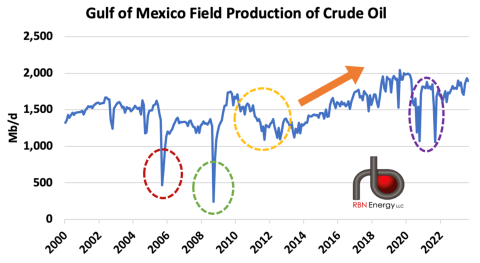Crude oil production in the offshore Gulf of Mexico (GOM) increased by more than 50% from 2013 to 2019, an extraordinary period of growth supported by new discoveries, new offshore platforms and new subsea tiebacks. Then, battered by Covid and major hurricanes, GOM output stumbled in 2020 and 2021, twice falling to less than 1.1 MMb/d, barely half the all-time mark of 2.04 MMb/d achieved in August 2019. More recently, production in the Gulf has been rebounding. But despite these gains — and a relatively mild 2023 hurricane season in the central and western Gulf — the region faces new challenges, including federal leasing delays, a significant oil spill, and an endangered species of sea giants known as Rice’s whales.
Just over a year ago, in Here Comes the Sun, we said that GOM producers have seen many ups and downs in the 21st century, including the setbacks that came with hurricanes Katrina and Rita in 2005 (dashed red oval in Figure 1), hurricanes Gustav and Ike in 2008 (dashed green oval), and the Deepwater Horizon spill in 2010, which spurred a steep, 18-month slide in production (dashed yellow oval). However, as illustrated by the orange arrow, the GOM then experienced its longest, largest period of production growth since the 1990s, when output roughly doubled.
During the 2013-19 growth spurt, producers in the Gulf made new discoveries, added a handful of new offshore platforms and — just as important (and maybe more so) — completed a slew of new subsea tiebacks, which “tie back” new wells to existing platforms with umbilical-cord-like connections. Tiebacks enable E&Ps to add new production much more quickly and at a fraction of the cost of new platforms (see Smooth Sailing).
Figure 1. Gulf of Mexico Field Production of Crude Oil. Source: EIA
Join Backstage Pass to Read Full Article











